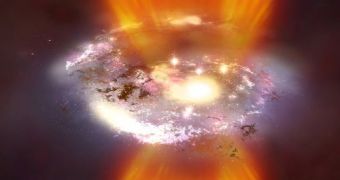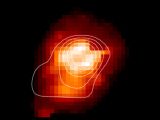An international group of researchers has recently determined that one of the earliest galaxies in the known Universe has had its star-forming abilities regulated by powerful, repeated blasts. The celestial structure was observed by astronomers as it looked some 3 billion years after the Big Bang, a time when the Universe was only a quarter of its present age. The finding sheds new light on how galaxies go about regulating their own growth process, the investigators say. The team that made the findings was led by researchers at the Durham University Department of Physics.
The explosions that plagued the observed galaxy, called SMM J1237+6203, were at least several trillion times more powerful than any atomic bomb’s, and they apparently took place once every second for millions of years. Eventually, the entire amount of gas that the structure would have otherwise used for stellar formation was dispersed. The main role played by the explosions was to help hydrogen escape the dramatic gravitational pull that the central regions of the galaxy – most likely containing a black hole – exerted on it. The violent events were therefore found to be guilty of hindering the emergence of blue stars in this particular corner of the Universe.
As per the experts, it would seem that the massive energy flows that caused this violent stir to happen were produced by either powerful stellar winds from supernovae, or by a tremendously-large outflow of energy from the central black hole's event horizon. Details of the idea are published in the latest issue of the respected scientific journal Monthly Notices of the Royal Astronomical Society. The work was funded with grant money from the Royal Society and the Royal Astronomical Society, and was conducted using the Gemini Observatory’s Near-Infrared Integral Field Spectrometer (NIFS) instrument.
“We are looking into the past and seeing a catastrophic event that essentially switched off star formation and halted the growth of a typical massive galaxy in the local Universe. Effectively the galaxy is regulating its growth by preventing new stars from being born. Theorists had predicted that huge outflows of energy were behind this activity, but it’s only now that we have seen it in action. We believe that similar huge outflows are likely to have stopped the growth of other galaxies in the early Universe by blowing away the materials needed for star formation,” says DU Department of Physics expert Dr Dave Alexander, who is also the lead author of the new investigation.

 14 DAY TRIAL //
14 DAY TRIAL // 
